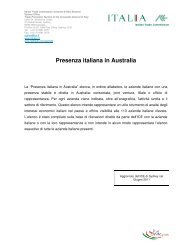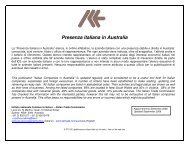Price Determination in the Australian Food Industry A Report
Price Determination in the Australian Food Industry A Report
Price Determination in the Australian Food Industry A Report
You also want an ePaper? Increase the reach of your titles
YUMPU automatically turns print PDFs into web optimized ePapers that Google loves.
DAIRY – ANALYSIS OF PRICING OF DAIRY SPREADS<br />
Overview of <strong>the</strong> product group<br />
Dairy spreads are a major product l<strong>in</strong>e <strong>in</strong> <strong>the</strong> <strong>Australian</strong> domestic dairy sector. Butter has been <strong>the</strong><br />
traditional ma<strong>in</strong>stay of <strong>the</strong> sector, however blends of butter and vegetable oil have overtaken retail<br />
sales volume of packaged butter.<br />
Butter is <strong>the</strong> major dairy spread product group. Approximately 50 per cent of butter product is<br />
exported (this varies year on year accord<strong>in</strong>g to market conditions and available product supply). Of<br />
<strong>the</strong> product consumed <strong>in</strong> <strong>the</strong> domestic market, about 85 per cent is sold as straight butter product<br />
– of which only 40 per cent is reported as sold <strong>in</strong> supermarkets. The rema<strong>in</strong>der is used <strong>in</strong> food<br />
service and <strong>in</strong>dustrial markets.<br />
Dairy spreads compete <strong>in</strong> <strong>the</strong> table spreads market aga<strong>in</strong>st margar<strong>in</strong>es (polyunsaturated and<br />
monounsaturated) which dom<strong>in</strong>ate <strong>the</strong> category with more than two-thirds of sales volume<br />
accord<strong>in</strong>g to 2002 supermarket data.<br />
Figure 22. Share of supermarket sales of spreads, 2002<br />
marg mono<br />
20%<br />
butter<br />
17%<br />
dairy blends<br />
17%<br />
marg poly<br />
46%<br />
Source: Dairy Australia<br />
Drivers of pric<strong>in</strong>g<br />
<strong>Price</strong> <strong>Determ<strong>in</strong>ation</strong> <strong>in</strong> <strong>the</strong> <strong>Australian</strong> <strong>Food</strong> <strong>Industry</strong> A <strong>Report</strong><br />
A number of factors have significantly affected pric<strong>in</strong>g <strong>in</strong> <strong>the</strong> dairy spreads value cha<strong>in</strong> <strong>in</strong> recent<br />
years:<br />
• major retailers moved to national supply contracts for private label dairy spread products;<br />
• prevail<strong>in</strong>g import parity prices for packaged butter and dairy blend products from New Zealand<br />
which are set by world market conditions. Such conditions are strongly <strong>in</strong>fluenced by <strong>the</strong> level of<br />
demand <strong>in</strong> major customer countries to which <strong>the</strong> <strong>in</strong>dustry has access, and <strong>the</strong> level of<br />
subsidised support paid to European Union butter exporters;<br />
• total steady decl<strong>in</strong>e <strong>in</strong> <strong>the</strong> overall table spreads category over time, fall<strong>in</strong>g steadily <strong>in</strong> total<br />
volumes each year s<strong>in</strong>ce <strong>the</strong> early 1990s (source: Ibisworld 2003d);<br />
• <strong>the</strong> long-term decl<strong>in</strong>e <strong>in</strong> consumer demand for butter products, offset by <strong>in</strong>creas<strong>in</strong>g demand for<br />
dairy blend spreads comb<strong>in</strong><strong>in</strong>g vegetable oils which have lower saturated fat content and<br />
properties which enable easier spread<strong>in</strong>g;<br />
• <strong>the</strong> existence of excess capacity <strong>in</strong> butter manufactur<strong>in</strong>g or <strong>in</strong>ventories on hand from time to<br />
time <strong>in</strong> <strong>the</strong> hands of <strong>the</strong> major manufacturers due to poor export market demand and/or<br />
prevail<strong>in</strong>g commodity prices; and<br />
• <strong>the</strong> use of private label and branded products at a discount from primary proprietary branded<br />
products to underp<strong>in</strong> a ga<strong>in</strong> <strong>in</strong> total market share by cha<strong>in</strong> retailers.<br />
30







